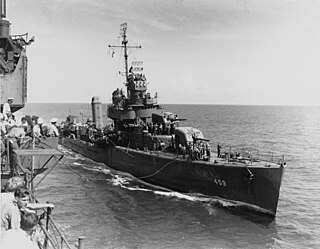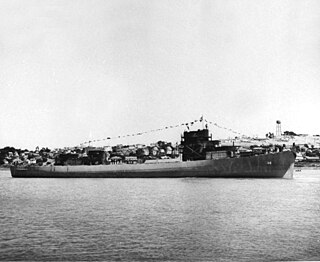This article is being considered for deletion in accordance with Wikipedia's deletion policy. Please share your thoughts on the matter at this article's deletion discussion page. |
John Leon Williamson | |
|---|---|
| Born | November 5, 1921 Ash, North Carolina |
| Died | November 12, 1942 (aged 21) |
| Allegiance | United States of America |
| Service/ | United States Navy |
| Years of service | 1940–1942 |
| Rank | Seaman First Class |
| Unit | USS San Francisco (CA-38) |
| Battles/wars | World War II *Naval Battle of Guadalcanal Battle of Cape Esperance |
| Awards | Navy Cross (posthumous) |
John Leon Williamson was born 5 November 1921 in Ash, North Carolina.
Williamson enlisted in the Navy at Raleigh, North Carolina, 11 July 1940. After recruit training, he was assigned to cruiser USS San Francisco (CA-38).
Williamson was on board the fighting cruiser during the attack on Pearl Harbor 7 December 1941 and the initial American amphibious assault of the war on Guadalcanal. He also took part in the American victory at the night Battle of Cape Esperance in October.
On 12 November 1942 one of the many Japanese attempts to bombard American positions in the Solomons and to reinforce their own garrisons there resulted another great battle, the Naval Battle of Guadalcanal. Before the main engagement, the USS San Francisco (CA-38) and other ships were attacked by torpedo bombers off Guadalcanal.
Williamson, an antiaircraft gunner fired at an approaching torpedo plane, remaining at his station with cool determination as the enemy aircraft crashed directly at his gun mount. For his great courage in the face of this attack, Seaman First Class Williamson was awarded the Navy Cross posthumously.
The USS John L. Williamson (DE-370) was named in his honor. She was laid down 22 May 1944 by Consolidated Steel Corp., Orange, Texas; launched 29 August 1944; sponsored by Mrs. Sherman Register, sister of Seaman First Class Williamson; and commissioned 31 October 1944, Lt. Comdr. J. E. Allen in command.

A cruiser is a type of warship. Modern cruisers are generally the largest ships in a fleet after aircraft carriers and amphibious assault ships, and can usually perform several roles.

USS New Orleans (CL/CA-32) was the lead New Orleans-class cruiser in service with the United States Navy. The New Orleans-class cruisers were the last U.S. cruisers built to the specifications and standards of the Washington Naval Treaty of 1922. Such ships, with a limit of 10,000 long tons (10,160 t) standard displacement and 8-inch (203-millimetre) calibre main guns may be referred to as "treaty cruisers." Originally classified a light cruiser, because of her thin armor, she was reclassified, soon after being laid down, a heavy cruiser, because of her 8-inch guns. The term "heavy cruiser" was not defined until the London Naval Treaty in 1930.

The first USS Juneau (CL-52) was a United States Navy Atlanta-class light cruiser sunk at the Naval Battle of Guadalcanal 13 November 1942. In total, 687 men, including the five Sullivan brothers, were killed in action as a result of its sinking. She was laid down by Federal Shipbuilding Company, Kearny, New Jersey, on 27 May 1940, launched on 25 October 1941, sponsored by Mrs. Harry I. Lucas, wife of the mayor of the city of Juneau, Alaska, and commissioned on 14 February 1942, Captain Lyman K. Swenson in command.

USS Chicago (CA-29) was a Northampton-class cruiser of the United States Navy that served in the Pacific Theater in the early years of World War II. She was the second US Navy ship to be named after the city of Chicago. After surviving a midget submarine attack at Sydney Harbour and serving in battle at the Coral Sea and Savo Island in 1942, she was sunk by Japanese aerial torpedoes in the Battle of Rennell Island, in the Solomon Islands, on 30 January 1943.

USS Honolulu (CL-48) of the United States Navy was a Brooklyn-class light cruiser active in the Pacific War. Honolulu was launched in 1937 and commissioned in 1938. The ship served in the Battle of Tassafaronga, the Battle of Kula Gulf, the Battle of Kolombangara and the Battle of Peleliu. She was taken out of action by serious torpedo damage just before the Battle of Leyte Gulf. She was repaired, but not in time to rejoin the war. She was decommissioned in 1947 and was held in reserve until she was scrapped in 1959.

USS Northampton (CL/CA-26) was the lead Northampton-class cruiser in service with the United States Navy. She was commissioned in 1930, originally classified a light cruiser because of her thin armor but later reclassified a heavy cruiser because of her 8-inch guns. During World War II she served in the Pacific and was sunk by Japanese torpedoes during the Battle of Tassafaronga on 30 November 1942. She was named after the city of Northampton, Massachusetts, the home of former President Calvin Coolidge.

The Mahan-class destroyers of the United States Navy were a series of 18 destroyers of which the first 16 were laid down in 1934. The last two of the 18, Dunlap and Fanning, are sometimes considered a separate ship class. All 18 were commissioned in 1936 and 1937. Mahan was the lead ship, named for Rear Admiral Alfred Thayer Mahan, an influential historian and theorist on sea power.

The second USS San Diego (CL-53) was an Atlanta-class light cruiser of the United States Navy, commissioned just after the US entry into World War II, and active throughout the Pacific theater. Armed with 16 5 in (127 mm)/38 cal DP anti-aircraft guns and 16 Bofors 40 mm AA guns, the Atlanta-class cruisers had one of the heaviest anti-aircraft broadsides of any warship of World War II.

The Atlanta-class cruisers were eight United States Navy light cruisers designed as fast scout cruisers or flotilla leaders but that proved to be effective anti-aircraft cruisers during World War II. They were also known as the Atlanta-Oakland class. The four Oakland and later ships had slightly different armament as they were further optimized for anti-aircraft fire. The Atlanta class had 12 x 5-inch (127 mm)/38 caliber guns, mounted in three superfiring sets of two-gun turrets fore and three more aft. The first four ships of the class also had an additional two twin 5-inch/38 mounts, one port and one starboard, giving these first four Atlanta-class cruisers the heaviest anti-aircraft armament of any cruiser of World War II.

USS Laffey (DD-459) was a Benson-class destroyer of the United States Navy during World War II. She was the first destroyer named for Bartlett Laffey.
George Irvin Falgout, enlisted in the United States Naval Reserve 19 February 1942. He was killed in action in the Naval Battle of Guadalcanal 12 November 1942, while serving in San Francisco (CA-38), heavily damaged in the battle. Seaman Second Class Falgout was posthumously awarded the Navy Cross for his great heroism and determination to defend his ship even at the cost of his life, when he remained at his gun, firing at a Japanese aircraft until it crashed into his station.
Eugene Frank George was a sailor in the United States Navy during World War II, who was posthumously awarded the Navy Cross.
USS Hubbard (DE-211/APD-53), a Buckley-class destroyer escort of the United States Navy, was named in honor of Commander Joseph C. Hubbard (1900-1942), who was killed in action, while serving aboard the heavy cruiser USS San Francisco (CA-38) during the Naval Battle of Guadalcanal on 13 November 1942.

Reinhardt John Keppler (January 22, 1918 – November 15, 1942) was an American navy serviceman who posthumously received the Medal of Honor for his actions during the Naval Battle of Guadalcanal in World War II.

Kinugasa was the second vessel in the two-vessel Aoba class of heavy cruisers in the Imperial Japanese Navy. The ship was named after Mount Kinugasa, located in Yokosuka, Kanagawa, Japan.

USS Eisele (DE-34) was an Evarts-class short-hull destroyer escort in the service of the United States Navy. The ship was named after Seaman Second Class George Raymond Eisele, killed in action on board the heavy cruiser USS San Francisco on 12 November 1942 during the Naval Battle of Guadalcanal.
Seaman Second Class Andrew Jackson Gandy was awarded the Navy Cross during World War II.

USS Gandy (DE-764) was a Cannon-class destroyer escort in service with the United States Navy from 1944 to 1946. In 1951, she was transferred to Italy, where she served as Altair until she was stricken and sunk as a target in 1971.
Frank Olga Slater was a Seaman 2nd Class of the United States Navy, killed in action aboard USS San Francisco (CA-38) off Savo Island during World War II, and subsequently awarded the Navy Cross.

USS John L. Williamson (DE-370) was a John C. Butler-class destroyer escort acquired by the U.S. Navy during World War II. The primary purpose of the destroyer escort was to escort and protect ships in convoy, in addition to other tasks as assigned, such as patrol or radar picket.